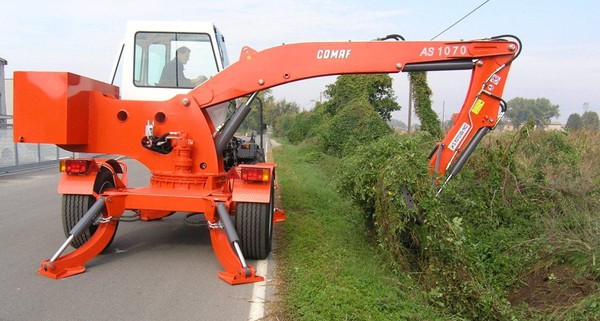
Trailed loaders/excavators in agricolture
Trailed loaders are in widespread use on farms for a variety of operation, from digging and loading bulk materials to cleaning ditches. These machines are made up of three fundamental structures, the frame, the arm and an hydraulic plant, can be equipped with a wide range of implements for various requirements and provide for accessories to ensure that all operations are performed in safe conditions
Almost every farm machinery inventory includes one which may be old or new but must be capable of digging, lifting and moving materials. This is the trailed loaded, a true multi-purpose machine working as the agricultural equivalent of an excavator. They consist of three fundamental structures, the frame, the arm and an hydraulic plant. The basic frame components are steel girders capable of handling all the stress of heavy loads, the arm, ballast and load, as well as the torsion strain they are subjected to. The frame can be single axle or two-axle, one with a fifth wheel coupling enhancing maneuverability. In the former case, part of the weight is offloaded to the tractor through the drawbar whereas the fifth wheel coupling does not take on weight to reduce heavy masses and stress on the towing vehicle. The fifth wheel coupling of the loader, however, causes a problem for maneuvers. As with all fifth wheel trailers, reversing is made more difficult than for single axle trailers. On the other hand, stress and heavy weight on the tractor can be reduced with the use of smaller trailed equipment. Some fifth wheel models – mainly those with an old design, but there are also new examples – are often equipped with an engine, often single cylinder or two cylinder motors which make it possible to use them without a tractor. Thus these types are assigned only for transferring the loader. Thus these means are advised mainly for stationary use.
Though there is no need of the fifth wheel coupling to increase stability because of the four wheels on the two axles, these trailed models can be exploited as support outriggers. These outriggers mounted on the frame between the wheels and the drawbar can be controlled manually with a jack or hydraulically. Once in position, these stabilizers make it possible to lighten the load weighing on the tractor and reduce mechanical stress. Moreover, they increase the lateral stability of the loader by transferring weight to four points rather than three, the wheels and the drawbar. Hydraulic outriggers are obviously more handy in that they can be operated directly from the machine without need for the operator to climb down every time they are actuated. This means the operator is more likely to use them in most any condition to increase safety on board the machine.
The arm
The arm is mounted on the frame, on a rotating turret platform with a fifth wheel coupling allowing it to rotate hydraulically. The angle of rotation can be 360°, that is enabling continuous 360° rotation in the same direction, or limited to 180° or slightly less than 360°. Rotation of 360° or less is often controlled by an hydraulic piston equipped with straight teeth gears which engage a teethed wheel. Continuous rotation, on the other hand, is performed with an hydraulic motor which acts directly on the fifth gear coupling.
The arm, the real operating part of the machine, is hinged on platform supports. For agricultural work, the arm is usually built in two sections. The first is the largest, hinged to the support with a strong bolt in hardened steel and fitted with a lubricator. This section is raised and lowered by a pistol which is also mounted on the platform support. The second section is hinged to the top of the first and is also operated by a piston. All the holes for hinging the various parts of the arm are fitted with wear sleeves which can be easily replaced when these is excessive play in the hinges. Two holes, both with wear sleeves, are on the end of the second arm for mounting the various attachments and the respective hydraulic control valves. Ballast is installed on the fifth wheel coupling on the side opposite the arm. The ballast consists of a big sheet steel box for loading with such heavy materials as gravel, scrap iron and the like to provide stability for the loader in operation.








